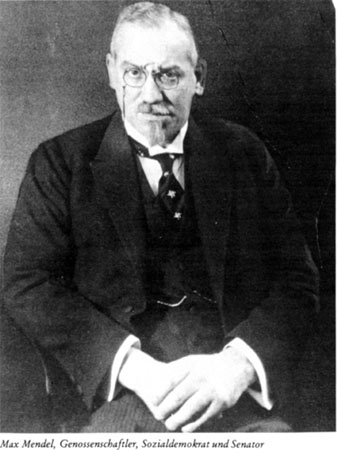Search for Names, Places and Biographies
Already layed Stumbling Stones
Suche
Max Mendel * 1872
Rathausmarkt 1 Rathaus (Hamburg-Mitte, Hamburg-Altstadt)
1942 Theresienstadt
tot 10.8.1942 (Senator FHH 1925-1929)
- http:/
/ de.wikipedia.org/ wiki/ Max_Mendel
(Max Mendel bei Wikipedia)
Ida Mendel, née Lobatz, born 8/3/1880, deported to Theresienstadt on 7/19/1942, died there 6/18/1943
Max Mendel, born 5/19/1872, deported to Theresienstadt on 7/19/1942, died there on 8/10/1942
Max Mendel was born on May 19th, 1872 into a family that had been residing in Hamburg for about 100 years already. His father was a wholesale trader of jute sacks and coal. He sent his son Max to the junior high school of the Johanneum. At the age of 14, Max had to leave school because of a severe illness that caused a permanent limp. His elder brother gave him private lessons, introducing him to socialist ideas.
Max Mendel absolved an apprenticeship at his father’s company and then studied economics and social sciences in Berlin for a couple of semesters. In 1900, he took the position of record keeper of the board of supervisors of "Produktion”, the consumers’ cooperative of the "Konsum, Spar- und Bauverein.” In 1909, he was appointed to its board of directors.
When the Hamburg city council introduced a special tax on consumers’ cooperatives in 1911, he countered this by founding "Produktion” trading company, open to everyone. The buildings of the "Pro” plants – as the organization was soon to be colloquially called – still exist today in the Hamm-Süd section of Hamburg.
In 1913, the German-Israelitic Community listed Max Mendel as a bank director. His first wife, Sofie, had died long before, and he married Anna, née Lobatz. The couple had two sons, Kurt, born 11/11/1903, and Robert, born 7/24/1907, and a daughter, Gertrud, born 5/26/1905. The Mendel family lived in Diagonalstrasse, near the "Pro” site in Diagonalstrasse 8. From 1925 to 1929, Max Mendel was economics minister in the Social Democratic Government of the City of Hamburg. He was assailed from all sides, including from within his own party, for his Judaism and his socio-economic undertakings – this antagonism finally caused him to resign.
The Mendels were erudite and cultured and led a privileged life, of which Max’ Nephew Arie Goral-Sternheim gives a vivid, colorful description in his autobiography "Jeckepotz.” In 1932, Max’ wife Anna died, and from then on, he shared his apartment at Hirtenstrasse 10 with his mother-in-law Bertha Lobatz and his sister-in-law Ida. The increasing overt anti-Semitism caused his sons Kurt and Robert to leave Germany. Gertrud married an "Aryan”, with the consequence that she and her son Ulrich were able to survive in Hamburg.
From Hirtenstrasse, Max Mendel, his mother-in-law and sister-in-law moved to Hammer Landstrasse 59, at the boundary between "upper” and "lower” Hamm. In 1938, Max married his sister-in-law Ida, born 8/3/1880 in Schwedt, the two years younger sister of his late wife Anna. Repeatedly, the Mendels shared their household with people who had been forced to leave their own homes. Max Mendel’s attempts to emigrate failed.
In 1941, the Mendels experienced the forced exitus of their neighbors, the Rosenbaums, who followed the order to be deported to Lodz. The Mendels themselves were relocated to a "Jews’ house” in Altona, Breite Strasse 46, where they were served the order to be deported to the Theresienstadt Ghetto on July 19th, 1942.
Max Mendel died three weeks after his arrival at the Ghetto. Ida Mendel died at 3:00 p.m. on June 18th, 1943, of a hemorrhage due to tuberculosis, according to the report of her death.
At the inauguration of the Stumbling Stones for the Mendel family, Max Mendel’s economic importance for Hamburg was compared to that of Albert Ballin. Ballindamm along the Binnenalster was named for Albert Ballin, Mendelstrasse in Lohbrügge for Max Mendel. In 2005, the 1000th Stumbling Stone in Hamburg was laid for Senator Max Mendel.
(Regarding the Lobatz-Mendel families see also Ulrich Bauche’s essay in 'Stolpersteine in Hamburg-Hamm', p. 148, see literature).
Translated by Peter Hubschmid
Kindly supported by the Hermann Reemtsma Stiftung, Hamburg.
Stand: October 2017
© Hildegard Thevs
Quellen: 1; 3; 4; 5; 7; StaH 552-1 Jüdische Gemeinde, o. Sign. Mitgliederzählung der DIGH 1928; 390 Wählerverzeichnis 1930; 391 Mitgliederliste 1935; 922 e 2 Deportationslisten Bd. 5; BA Bln., Volkszählung 1939; AfW 190572; Archivum Panstwowe, Lodz; Goral-Sternheim, Arie: Jeckepotz. Eine jüdisch-deutsche Jugend 1914–1933, Hamburg 1989. Das Jüdische Hamburg. Hrsg. vom Institut für die Geschichte der deutschen Juden. Göttingen 2006, S. 188f.; Hamburgische Biographie. Personenlexikon. Hrsg. von Frank Kopitzsch und Dirk Brietzke, Bd. 1, S. 201f.
Zur Nummerierung häufig genutzter Quellen siehe Link "Recherche und Quellen".


